Text
Tiny NASA Cameras to Watch Commercial Lander form Craters on Moon
youtube
Footage from vibration and thermal vacuum testing of the SCALPSS cameras and data storage unit.
Credits: NASA/Gary Banziger
This little black camera looks like something out of a spy movie — the kind of device one might use to snap discrete photos of confidential documents.
It's about half the size of a computer mouse.
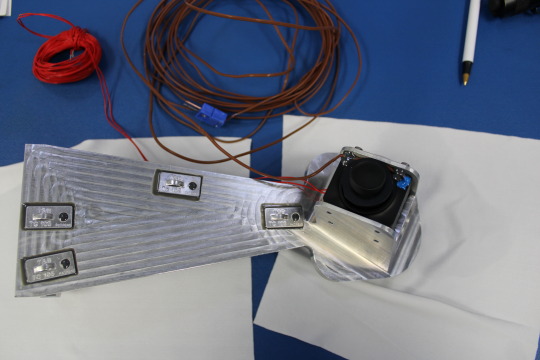
The SCALPSS cameras, one of which is pictured here prior to thermal vacuum testing, are about the size of a computer mouse. Credits: NASA
But the only spying this camera — four of them, actually — will do is for NASA researchers wondering what happens under a spacecraft as it lands on the Moon.
It's a tiny technology with a big name — Stereo Camera for Lunar Plume-Surface Studies, or SCALPSS for short — and it will journey to the Moon in 2021 as a payload aboard an Intuitive Machines Nova-C lunar lander spacecraft. Intuitive Machines is one of two U.S. companies delivering technology and science experiments to the lunar surface later this year as part of NASA's Commercial Lunar Payload Services (CLPS) initiative. SCALPSS will provide important data about the crater formed by the rocket plume of the lander as it makes its final descent and landing on the Moon's surface.
As part of the Artemis program, NASA will send robots and humans to study more of the Moon than ever before. The agency plans to establish sustainable lunar exploration by the end of the decade, and has outlined its Artemis Base Camp concept for the lunar South Pole. Landers may deliver multiple payloads very near one another. Data such as that from SCALPSS will prove aid in computer models that inform subsequent landings.
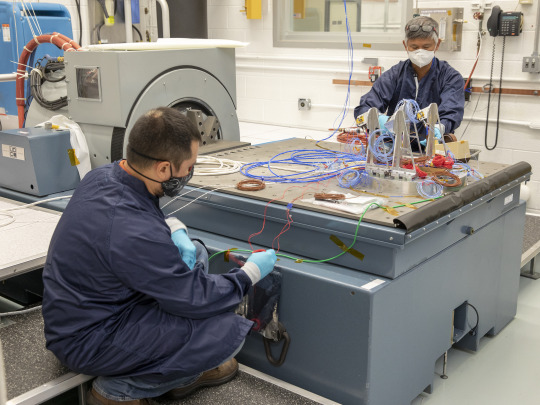
SCALPSS team members prepare the cameras and data storage unit for vibration testing. Credits: NASA/David C. Bowman
"As we send bigger, heavier payloads and we try to land things in close proximity to each other, first at the Moon then at Mars, this ability to predict landing impacts is very important," said Michelle Munk, principal investigator for SCALPSS at NASA's Langley Research Center in Hampton, Virginia.
The four SCALPSS cameras, which will be placed around the base of the commercial lander, will begin monitoring crater formation from the precise moment a lander's hot engine plume begins to interact with the Moon's surface.
"If you don't see the crater when it starts to form, you can't really model it," said Munk. "You've got to have the start point and the end point and then you can figure out what happened, in between."
The cameras will continue capturing images until after the landing is complete. Those final stereo images, which will be stored on a small onboard data storage unit before being sent to the lander for downlink back to Earth, will allow researchers to reconstruct the crater's ultimate shape and volume.

The SCALPSS data storage unit will store the imagery the cameras collect as the Intuitive Machines Nova-C lunar lander spacecraft makes its final descent and lands on the Moon's surface. Credits: NASA
Testing to characterize the SCALPSS camera and lens took place last year at NASA's Marshall Space Flight Center in Huntsville, Alabama. Researchers conducted radial distortion, field-of-view and depth-of-focus tests among others. They also ran analytical models to better characterize how the cameras will perform. Development of the actual SCALPSS payload took place at Langley. And over the summer, researchers were able to enter the lab to assemble the payload and conduct thermal vacuum and vibration tests.
That lab access involves special approval from officials at Langley, which is currently only giving access to essential employees and high-priority projects to keep employees safe during the ongoing COVID-19 pandemic. SCALPSS was one of the first projects to return to the center. Before they could do that, facilities had to pass safety and hazard assessments. And while on center, the team had to follow strict COVID-19 safety measures, such as wearing masks and limiting the number of people who could be in a room at one time. The center also provided ample access to personal protective equipment and hand sanitizer.
The SCALPSS hardware was completed in late October and will be delivered to Intuitive Machines in February.
"Development and testing for the project moved at a pretty brisk pace with very limited funds," said Robert Maddock, SCALPSS project manager. "This was likely one of the most challenging projects anyone on the team has ever worked on."
But Munk, Maddock and the entire project team have embraced these challenges because they know the images these little cameras collect may have big ripple effects as NASA prepares for a human return to the Moon as part of the Artemis program.
"To be able to get flight data and update models and influence other designs — it's really motivating and rewarding," said Munk.
Hot off the heels of this project, the SCALPSS team has already begun development of a second payload called SCALPSS 1.1. It will be flown by another CLPS commercial lander provider to a non-polar region of the Moon in 2023 and collect data similar to its predecessor. It will also carry two additional cameras to get higher resolution stereo images of the landing area before engine plume interactions begin, which is critical for the analytic models in establishing the initial conditions for the interactions.
NASA’s Artemis program includes sending a suite of new science instruments and technology demonstrations to study the Moon, landing the first woman and next man on the lunar surface in 2024, and establishing a sustained presence by the end of the decade. The agency will leverage its Artemis experience and technologies to prepare for humanity’s the next giant leap – sending astronauts to Mars as early as the 2030s.
Joe Atkinson
NASA Langley Research Center
10 notes
·
View notes
Text
At Langley, Admiration and Gratitude Multiply on Katherine Johnson’s 100th Birthday

When Jasmine Byrd started her job at NASA about two years ago, she knew nothing about Katherine Johnson, the mathematician and “human computer” whose achievements helped inspire the book and movie “Hidden Figures.”

Jasmine Byrd, who works as a project coordinator at NASA's Langley Research Center, looks at an image of Katherine G. Johnson in the lobby of the building named in Johnson's honor. "I was just enthralled with her story," Byrd said.
Credits: NASA/David C. Bowman
At that point, the release of the film was still months away. But excitement was building — particularly at Byrd’s new workplace. She’d arrived at NASA’s Langley Research Center in Hampton, Virginia, where Johnson spent her entire, 33-year NACA and NASA career.
Soon, Byrd felt a strong connection to a woman she’d never met, nearly 70 years her senior.
“I was just enthralled with her story,” said Byrd, a project coordinator for NASA’s Convergent Aeronautics Solutions Project. Today, she works inside Langley’s Building 1244, the same hangar-side location where Johnson crunched numbers for the Flight Research Division in the 1950s.

View images of Katherine G. Johnson through the years at this photo gallery: https://go.nasa.gov/2MskBOq
Credits: NASA via Flickr
“I am thankful for the bridge that Katherine built for someone like myself to easily walk across,” Byrd said. “It helps me to not take this opportunity for granted. I know there were people before me who put in a lot of work and went through a lot of turmoil at times to make sure it was easier for people like myself.”
Fountain of gratitude
As Katherine G. Johnson’s 100th birthday — Aug. 26 — approached, many Langley employees expressed admiration for the woman whose math powered some of America’s first triumphs in human space exploration.
Johnson did trajectory analysis for Alan Shepard’s May 1961 mission Freedom 7, America’s first human spaceflight. At a time when digital computers were relatively new and untested, she famously checked the computer’s math for John Glenn’s historic first orbital spaceflight by an American in February of 1962.
Those are just two bullet points in a brilliant career that stretched from 1953 to 1986.
Her 100th birthday was recognized throughout NASA and around the world. But at Langley, the milestone created an extra measure of pride and joy.
Graduate research assistant Cecilia Stoner, stopped on her way to Langley’s cafeteria, said she admires how Johnson remained humble — even when showered with accolades ranging from the Presidential Medal of Freedom to toys made in her likeness.
Stoner’s lunch companion, Erin Krist, chimed in. “It’s incredible what she managed to do,” said Krist, a summer intern. “She paved the way for women. We couldn’t work here today if that hadn’t happened.”
Langley’s acting chief technologist, Julie Williams-Byrd, echoed that thought.
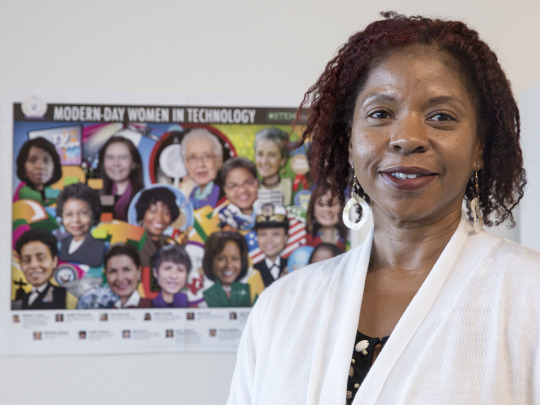
Julie Williams-Byrd, acting chief technologist at NASA's Langley Research Center, said she admires Katherine Johnson's technical excellence and support of STEM education.
Credits: NASA/David C. Bowman
“She opened the doors for the rest of us,” Williams-Byrd said. “Between her and Dorothy Vaughan and Mary Jackson and all the women who were at Langley at the time. It didn’t matter if they were called computers in skirts. They were here to do a job.
“It’s typical NASA culture, right?” Williams-Byrd said. “We have a mission. Everybody’s going to jump in and do what they can to make that mission successful.”
She also admires Johnson’s devotion to promoting science, technology, engineering and math studies among young people.
“While she was very focused on the technical work and really did great things there, her balance of life and responsibilities to those who would come up behind her, that really resonates with me,” Williams-Byrd said.
A modest mentor
Remarkably, a handful of current Langley employees worked side by side with Johnson. Among them is research mathematician Daniel Giesy, who started at the center in 1977.
“On my first job here, I was teamed with Katherine Johnson,” Giesy said. “She mentored me.”
Johnson showed Giesy the ropes as he and Johnson both provided mathematical and computer programming support for researchers working to find new tools for designing aircraft control systems. They eventually coauthored papers including “Application of Multiobjective Optimization in Aircraft Control Systems Design” from 1979, written with Dan Tabak.
“I would describe her as a good colleague, competent, courteous,” Giesy said. “She had her moments. If you slopped coffee on the way back from the break room, you bloody well better clean up after yourself. You don’t leave it for the janitor staff to work on.
“But she was focused on getting the job done,” Giesy said. “At that point in time, she wasn’t resting on laurels.” Only later would Giesy learn of her historic contributions to early space missions. “She did not brag on herself particularly.”
Regina Johns, who today recruits participants for tests related to crew systems, aviation operations and acoustics, arrived at Langley in 1968 as a high school intern. She returned as a contract employee in 1973 and has worked at Langley ever since.

This 1985 photo shows Katherine G. Johnson — front row, blue dress — posing with the Langley team she worked with at the time. Her coworker Dan Giesy is the bearded man two rows behind her on the far right.
Credits: NASA
In those early days, she remembers running into Johnson on campus occasionally. Johnson would often stop and talk, asking about her plans and what she was working on. Johns would eventually get to know Mary Jackson, another Langley researcher central to the “Hidden Figures” story.
“There weren’t a lot of minorities here at that time,” Johns said. “To know that they were engineers and mathematicians, it just gave me hope that, if they can do it, it can be done. If you work hard, you can do it.”
She, like many across the agency, said she’d like to send Johnson a birthday message.
“If I had a chance, I would say, thank you for setting the pathway for young people. Thank you for showing us that we can do anything.”
Enduring legacy
In terms of lives touched, Johnson’s work with youth stands alongside her impact as a world-class mathematician. Langley’s Katherine G. Johnson Computational Research Facility, which opened in September 2017, offers a physical reminder of her contributions.
“The Katherine Johnson building is near where I work, so I think about her often,” said Kimberly Bloom, director of Langley’s Child Development Center. Johnson’s life and accomplishments would have deserved attention even if Hollywood hadn’t come calling, she suggests.
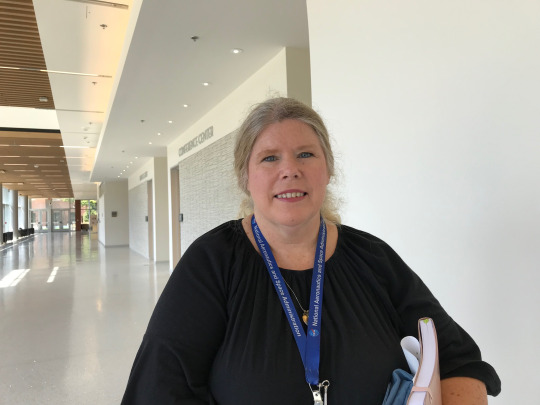
Kimberly Bloom, director of Langley's Child Development Center, said Katherine Johnson made a positive impact on NASA culture and on America as a whole.
Credits: NASA/Sam McDonald
“It’s an important story — how she empowered women of all races,” Bloom said. “And she encouraged kids to learn. She influenced culture here at NASA, but also beyond and made an impact. She certainly is a role model.
“I’d like to thank her for all she’s done not only for NASA but also for this country,” Bloom said.
Learn more about Katherine G. Johnson's life and contributions to NASA at this link.
Sam McDonald
NASA Langley Research Center
37 notes
·
View notes
Text
Brothers Bring Curious Minds, Sharp Questions to Langley

One brother is a facts-and-figures guy, the other an adventurer.
They're both deeply fascinated by all things space.
Mikey and Robbie Rouse, 15 and 16, are from Salem, Virginia, and both have Duchenne Muscular Dystrophy, a progressive condition that affects nearly all their voluntary muscles.
On a recent trip to Hampton, Virginia, they visited one of the birthplaces of the American space program — NASA's Langley Research Center.

Mikey, the adventurer, wants to be the first wheelchair astronaut. "And I want to go to Mars," he said during his visit.
Robbie, the facts-and-figures guy, is always thinking of safety first — a quality held sacred by all at NASA.
The brothers' visit to Langley included a tour of the center's hangar, a stop at the Flight Mission Support Center for the ozone-monitoring Stratospheric Aerosol and Gas Experiment III, and presentations on the Hypersonic Inflatable Aerodynamic Decelerator, autonomous technologies, and tests at the Landing and Impact Research Facility.
Deputy Center Director Clayton Turner and Associate Director Cathy Mangum presented Mikey and Robbie with commemorative coins and copies of "A Century at Langley," a pictoral history of the center.
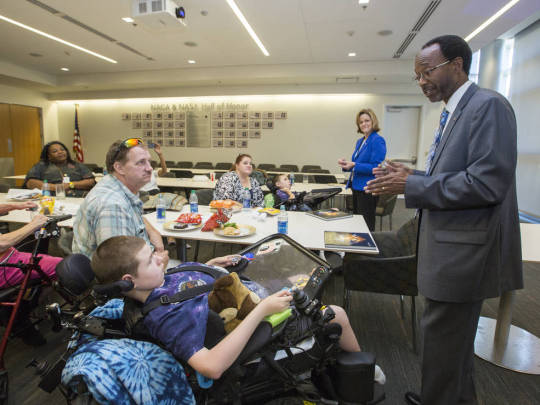
No subject raised during the visit failed to spark the boys' curiosity.
Steve Velotas, associate director for intelligent flight systems, talked with Mikey and Robbie about the ways in which Langley researchers are studying autonmous technologies. Autonomous systems could be used in unmanned aerial vehicles, in-space assembly robots, or even wheelchairs to help those with disabilities navigate more easily.
"I don't trust robots completely," Mikey said.
"We don't either," said Velotas, who then explained that part of the reason Langley scientists are studying autonomous systems is to make sure they work like people want them to.
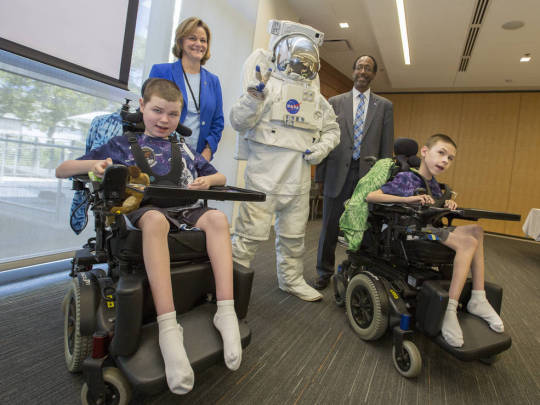
Evan Horowitz, structures and mechanical systems airworthiness engineer, showed the brothers Langley's historic hangar and talked about some of the past and present missions the facility has supported.
Gemini and Apollo astronauts trained in the hangar's Rendezvous Docking Simulator, and aircraft used for airborne science studies and autonomous flight research are based there.
Mikey and Robbie peppered Horowitz, who often takes tour groups through the hangar, with questions about air pollution and habitable exoplanets.
"This is great," said Horowitz. "Best interaction I've had in months."
The previous day, Mikey and Robbie visited the Virginia Air & Space Center, Langley's official visitors center.
The brothers live with their great-grandmother in Salem and receive daily assistance from a nonprofit called Lutheran Family Services of Virginia. The trip to Hampton was organized by Julie's Abundance Project, a program of Lutheran Family Services of Virginia.

Image Credits: NASA/David C. Bowman
Joe AtkinsonJoe Atkinson
NASA Langley Research Center
58 notes
·
View notes
Video
youtube
The NASA Aeronautics team is working to transform aviation by enabling a new commercial market for supersonic travel over land. The centerpiece of this effort is the X-59 QueSST (short for Quiet SuperSonic Technology), a new X-plane designed to produce sonic "thumps" that could open the door to new certification standards for commercial supersonic service. NASA and Lockheed Martin are working together to design and build the X-59. Beginning in 2023, NASA will use this X-plane to measure public response to sonic thumps.
More at www.nasa.gov/lowboom
28 notes
·
View notes
Text
Help NASA Track and Predict Mosquito-Borne Disease Outbreaks
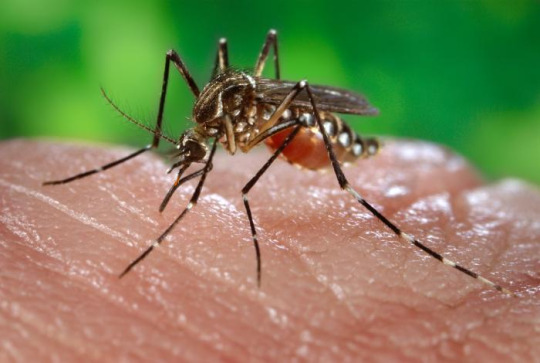
Picnics, parades and fireworks are the attributes of a grand July Fourth celebration. So are the itch and scratch of mosquito bites. While the bites are annoying, they don't tend to stop the festivities. However, certain types of mosquitoes can cause serious harm. They are known to carry and spread diseases like Zika, West Nile Virus and malaria.
One of the tools researchers are using to track these mosquitos is citizen science data combining with NASA Earth satellite observations to create new forecast models that can predict the spread of mosquito-carrying diseases, but more data are needed to improve models that can predict and track mosquito-borne diseases.
“We do not have enough information on the geographic distribution of mosquito and time-variation in their populations. If a lot of people participated in this citizen science initiative worldwide, it will help fill in gaps and that would help our work,” said Assaf Anyamba, a scientist from Universities Space Research Association using satellite data to study mosquitoes at NASA's Goddard Space Flight Center in Greenbelt, Maryland.
From fall 2017 to spring 2018, two NASA DEVELOP teams at Goddard studied Western Europe, a place not typically known for mosquito disease outbreaks. DEVELOP, part of NASA’s Applied Sciences Program, addresses environmental and public policy issues through interdisciplinary research projects that apply the lens of NASA Earth observations to community concerns around the globe. The Global Mosquito Alert Consortium supplied the DEVELOP teams with citizen science data.
youtube
The teams blended the citizen science data with NASA satellite observations of land surface temperatures, humidity, soil moisture, elevation, vegetation and precipitation. The data were then used to create an interactive, open-source map on Google Earth Engine to improve prediction models for disease-carrying mosquitoes. The work is ongoing.
Early results showed that vegetation, humidity and soil moisture made it easier for mosquitoes to thrive during the summer months. During the winter, elevation played a stronger role in creating mosquito-friendly habitats. The lower the altitude, the higher the number of mosquitoes. One challenge with the study was that the citizen science data was concentrated in populated areas; and as a result, it was skewing some of the mosquito results,” said Sara Lubkin, DEVELOP project coordination fellow at Goddard.
More citizen science data from more areas of the world could help.
“Knowing the mosquito species and their approximate populations at a given time provides useful information on the potential of occurrence of a particular pathogen, or disease transmission,” said Anyamba.
Different environmental conditions are suitable for certain types of disease-carrying mosquitoes.
Every summer, hot, humid conditions drive up mosquito populations. Since there are plenty of wet areas to live and breed, mosquitoes tend to stay in one area. However, when conditions become hot and dry, mosquitoes migrate to more suitable habitats.
Satellites can detect how wet or how dry an area is, and that information helps determine what types of mosquitoes and disease can move through an environment.
The last significant West Nile outbreak in the United States occurred in 2011, which was a dry year. The hot, dry season led mosquitoes to move into highly urbanized and populated areas seeking food and water.
Warmer temperatures excite some mosquito species, causing them to bite more people. Also, certain high temperature thresholds can reduce the amount of time it takes for mosquitoes to mature from larvae to adults leading to doubling mosquito populations over an average year.
Mosquitoes cannot travel far on their own. Instead, they have to hitch a ride on people and animals to travel any significant distance. If a mosquito is a type that carries and spreads diseases, then the disease can move into new areas, as occurred in Western Europe.

The public can help track mosquitoes by downloading an app called GLOBE Observer, and then collect data over the summer using the Mosquito Habitat Mapper tool in the app. The app guides users through the process of identifying and eliminating mosquito breeding sites in order to reduce mosquito populations in their local area.
Related links:
An Interactive Model of Mosquito Presence and Distribution to Assist Vector-Borne Disease Management in Western Europe
A new report from the National Center for Atmospheric Research evaluates the risk to 50 U.S. cities from the Aedes aegypti mosquito, which carries Zika.
Global Mosquito Alert Consortium
NASA Citizen Science App Tackles Mosquito-Borne Disease
By Rani Gran
NASA's Goddard Space Flight Center, Greenbelt, Md.
16 notes
·
View notes
Video
youtube
NASA Langley researchers are working on various projects to improve commercial airliner cockpit simulators to reduce the risk of loss-of-control in flight. This includes improving simulator fidelity for stall training, and also includes a partnership with the U.S. Navy, at the Disorientation Research Device Facility in Dayton, Ohio, to develop and evaluate synthetic vision displays to help pilots recover from upsets or unusual attitudes.
NASA Langley Research Center
83 notes
·
View notes
Text
5 Out-of-This World Technologies Developed for Our Webb Space Telescope
Our James Webb Space Telescope is the most ambitious and complex space science observatory ever built. It will study every phase in the history of our universe, ranging from the first luminous glows after the Big Bang, to the formation of solar systems capable of supporting life on planets like Earth, to the evolution of our own Solar System.
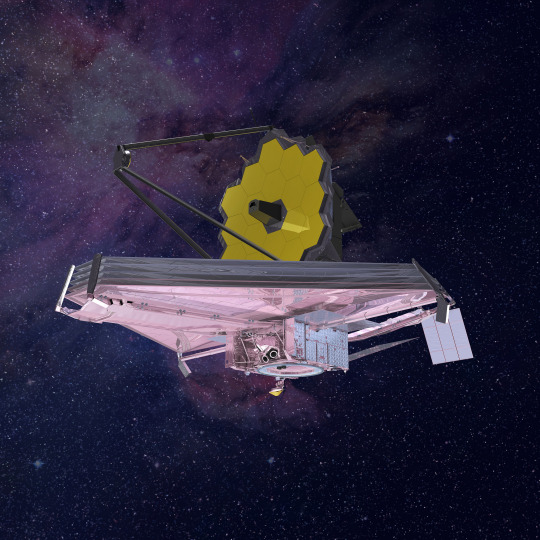
In order to carry out such a daring mission, many innovative and powerful new technologies were developed specifically to enable Webb to achieve its primary mission.
Here are 5 technologies that were developed to help Webb push the boundaries of space exploration and discovery:
1. Microshutters
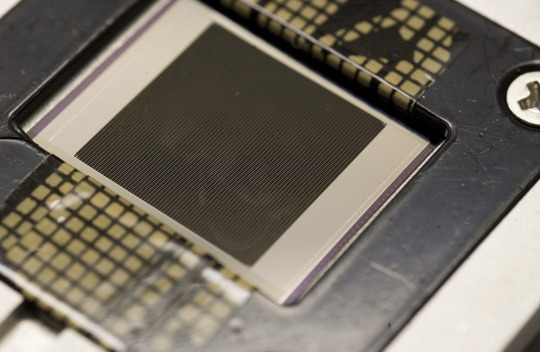
Microshutters are basically tiny windows with shutters that each measure 100 by 200 microns, or about the size of a bundle of only a few human hairs.
The microshutter device will record the spectra of light from distant objects (spectroscopy is simply the science of measuring the intensity of light at different wavelengths. The graphical representations of these measurements are called spectra.)

Other spectroscopic instruments have flown in space before but none have had the capability to enable high-resolution observation of up to 100 objects simultaneously, which means much more scientific investigating can get done in less time.
Read more about how the microshutters work HERE.
2. The Backplane
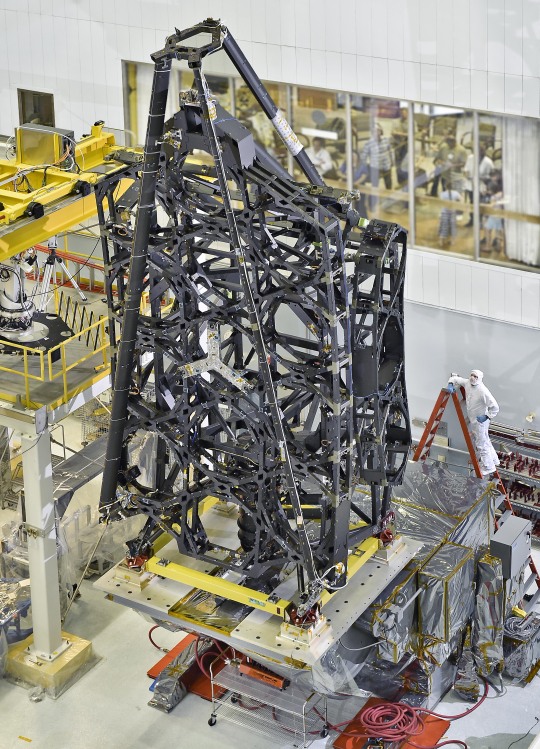
Webb’s backplane is the large structure that holds and supports the big hexagonal mirrors of the telescope, you can think of it as the telescope’s “spine”. The backplane has an important job as it must carry not only the 6.5 m (over 21 foot) diameter primary mirror plus other telescope optics, but also the entire module of scientific instruments. It also needs to be essentially motionless while the mirrors move to see far into deep space. All told, the backplane carries more than 2400kg (2.5 tons) of hardware.
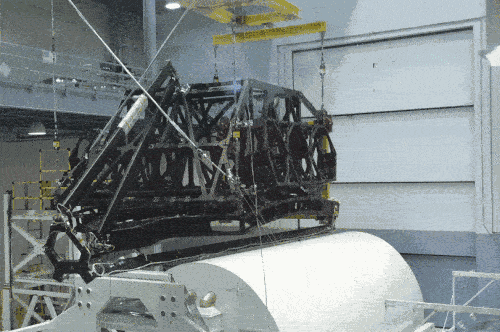
This structure is also designed to provide unprecedented thermal stability performance at temperatures colder than -400°F (-240°C). At these temperatures, the backplane was engineered to be steady down to 32 nanometers, which is 1/10,000 the diameter of a human hair!
Read more about the backplane HERE.
3. The Mirrors
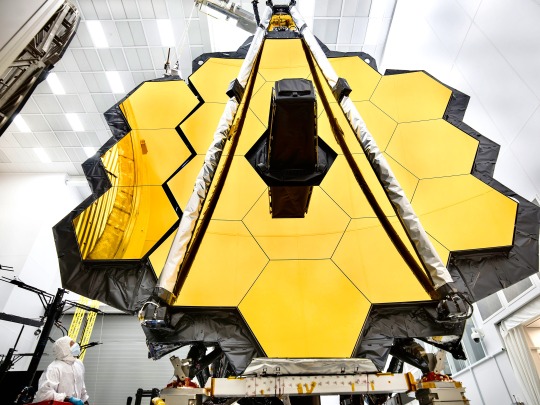
One of the Webb Space Telescope’s science goals is to look back through time to when galaxies were first forming. Webb will do this by observing galaxies that are very distant, at over 13 billion light years away from us. To see such far-off and faint objects, Webb needs a large mirror.
Webb’s scientists and engineers determined that a primary mirror 6.5 meters across is what was needed to measure the light from these distant galaxies. Building a mirror this large is challenging, even for use on the ground. Plus, a mirror this large has never been launched into space before!
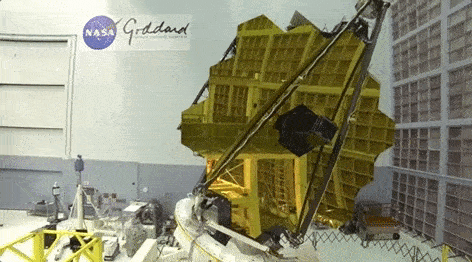
If the Hubble Space Telescope’s 2.4-meter mirror were scaled to be large enough for Webb, it would be too heavy to launch into orbit. The Webb team had to find new ways to build the mirror so that it would be light enough - only 1/10 of the mass of Hubble’s mirror per unit area - yet very strong.
Read more about how we designed and created Webb’s unique mirrors HERE.
4. Wavefront Sensing and Control
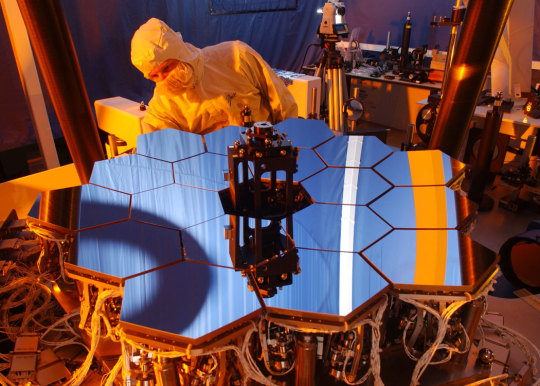
Wavefront sensing and control is a technical term used to describe the subsystem that was required to sense and correct any errors in the telescope’s optics. This is especially necessary because all 18 segments have to work together as a single giant mirror.
The work performed on the telescope optics resulted in a NASA tech spinoff for diagnosing eye conditions and accurate mapping of the eye. This spinoff supports research in cataracts, keratoconus (an eye condition that causes reduced vision), and eye movement – and improvements in the LASIK procedure.
Read more about the tech spinoff HERE.
5. Sunshield and Sunshield Coating

Webb’s primary science comes from infrared light, which is essentially heat energy. To detect the extremely faint heat signals of astronomical objects that are incredibly far away, the telescope itself has to be very cold and stable. This means we not only have to protect Webb from external sources of light and heat (like the Sun and the Earth), but we also have to make all the telescope elements very cold so they don’t emit their own heat energy that could swamp the sensitive instruments. The temperature also must be kept constant so that materials aren’t shrinking and expanding, which would throw off the precise alignment of the optics.
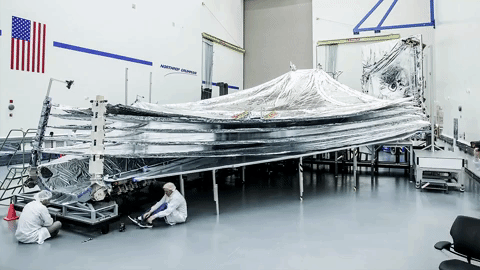
Each of the five layers of the sunshield is incredibly thin. Despite the thin layers, they will keep the cold side of the telescope at around -400°F (-240°C), while the Sun-facing side will be 185°F (85°C). This means you could actually freeze nitrogen on the cold side (not just liquify it), and almost boil water on the hot side. The sunshield gives the telescope the equivalent protection of a sunscreen with SPF 1 million!
Read more about Webb’s incredible sunshield HERE.
Learn more about the Webb Space Telescope and other complex technologies that have been created for the first time by visiting THIS page.
For the latest updates and news on the Webb Space Telescope, follow the mission on Twitter, Facebook and Instagram.
Make sure to follow us on Tumblr for your regular dose of space: http://nasa.tumblr.com.
4K notes
·
View notes
Video
youtube
Life at the Lab: Dummies Crash Planes!
Get a behind-the-scenes look at how test dummies at NASA's Langley Research Center contribute to making the planes we fly on safer and developing space exploration vehicles. Work ranges from next-generation aircraft to water-impact tests that evaluate the splashdown of Orion astronaut crew capsules returning from space.
Credit: NASA/Videographer: Gary Banziger; Writer and Co-Producer: Lily Daniels; Editor and Co-Producer: Kevin Anderson
9 notes
·
View notes
Video
youtube
NASA Langley researchers are experts in modeling and simulations for entry, descent and landing, working on missions since the Viking lander in 1976. In this episode, we explore the challenges of guiding landers like Mars InSight through the Martian atmosphere for a safe landing.



NASA InSight launched on March 5, 2018.
For more, visit https://mars.nasa.gov/insight/
30 notes
·
View notes
Text
What's Up? - May 2018

What’s Up For May?
The Moon and Saturn meet Mars in the morning as our InSight spacecraft launches to the Red Planet on May 5!
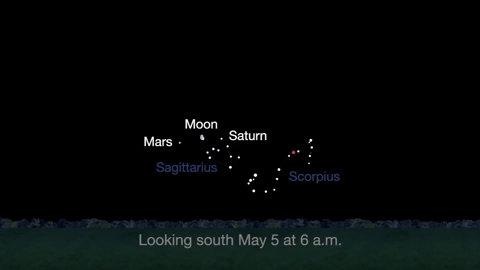
You won’t want to miss red Mars in the southern morning skies this month.

InSight, our first mission to explore Mars’ deep interior, launches on May 5th with a launch window that begins at 4:05 a.m. PDT and lasts for two hours.
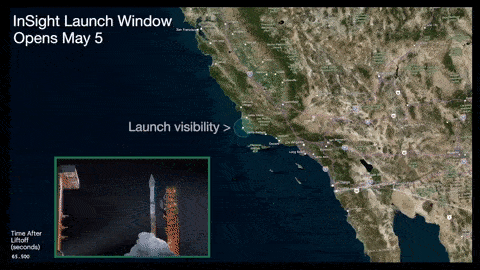
Some lucky viewers in central and southern California and even parts of the Mexican Pacific coast will get a chance to see the spacecraft launch with their unaided eyes AND its destination, Mars, at the same time.

Mars shines a little brighter than last month, as it approaches opposition on July 27th. That’s when Mars and the Sun will be on opposite sides of the Earth. This will be Mars’ closest approach to Earth since 2003!

Compare the planet’s increases in brightness with your own eyes between now and July 27th.

The Eta Aquarid meteor shower will be washed out by the Moon this month, but if you are awake for the InSight launch anyway, have a look. This shower is better viewed from the southern hemisphere, but medium rates of 10 to 30 meteors per hour MAY be seen before dawn.

Of course, you could travel to the South Pacific to see the shower at its best!

There’s no sharp peak to this shower–just several nights with good rates, centered on May 6th.

Jupiter reaches opposition on May 9th, heralding the best Jupiter-observing season, especially for mid-evening viewing. That’s because the king of the planets rises at sunset and sets at dawn.

Wait a few hours after sunset, when Jupiter is higher in the sky, for the best views. If you viewed Jupiter last month, expect the view to be even better this month!
Watch the full What’s Up for May Video:
youtube
There are so many sights to see in the sky. To stay informed, subscribe to our What’s Up video series on Facebook.
Make sure to follow us on Tumblr for your regular dose of space: http://nasa.tumblr.com.
2K notes
·
View notes
Photo
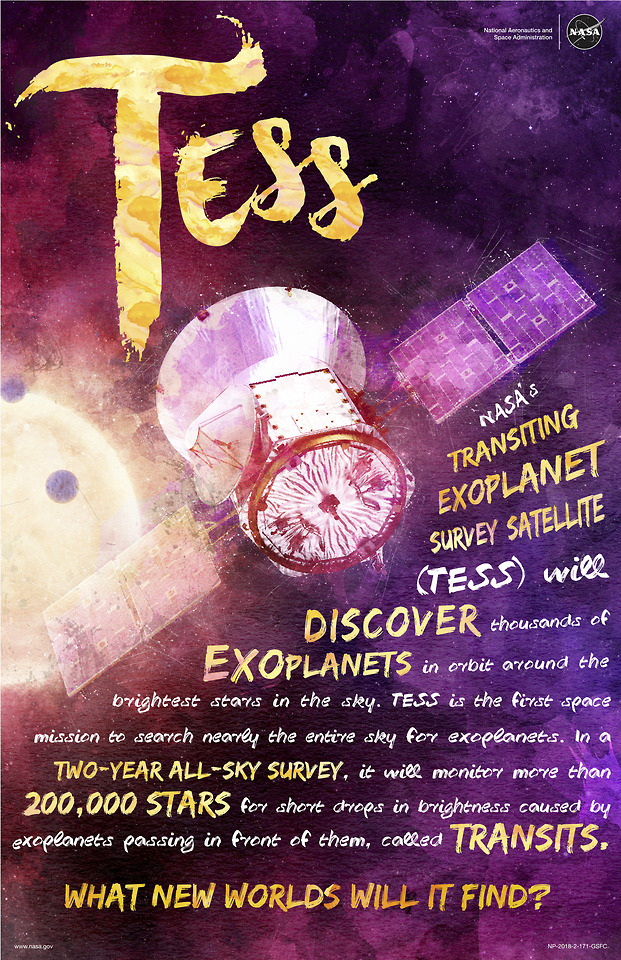
Learn more about the Transiting Exoplanet Survey Satellite (TESS) at: http://tess.gsfc.nasa.gov/
Watch live coverage of today’s (Wed. April 18, 2018) launch at: http://www.nasa.gov/nasalive/
6 notes
·
View notes
Text
The Hunt for New Worlds Continues with TESS
We’re getting ready to start our next mission to find new worlds! The Transiting Exoplanet Survey Satellite (TESS) will find thousands of planets beyond our solar system for us to study in more detail. It’s preparing to launch from our Kennedy Space Center at Cape Canaveral in Florida.

Once it launches, TESS will look for new planets that orbit bright stars relatively close to Earth. We’re expecting to find giant planets, like Jupiter, but we’re also predicting we’ll find Earth-sized planets. Most of those planets will be within 300 light-years of Earth, which will make follow-up studies easier for other observatories.

TESS will find these new exoplanets by looking for their transits. A transit is a temporary dip in a star’s brightness that happens with predictable timing when a planet crosses between us and the star. The information we get from transits can tell us about the size of the planet relative to the size of its star. We’ve found nearly 3,000 planets using the transit method, many with our Kepler space telescope. That’s over 75% of all the exoplanets we’ve found so far!

TESS will look at nearly the entire sky (about 85%) over two years. The mission divides the sky into 26 sectors. TESS will look at 13 of them in the southern sky during its first year before scanning the northern sky the year after.

What makes TESS different from the other planet-hunting missions that have come before it? The Kepler mission (yellow) looked continually at one small patch of sky, spotting dim stars and their planets that are between 300 and 3,000 light-years away. TESS (blue) will look at almost the whole sky in sections, finding bright stars and their planets that are between 30 and 300 light-years away.
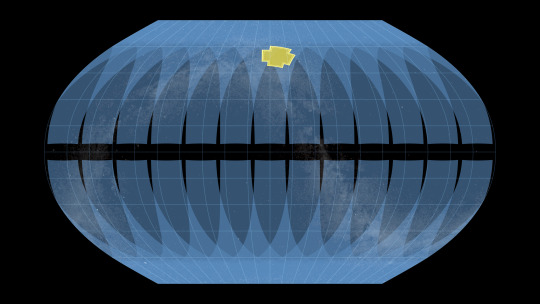
TESS will also have a brand new kind of orbit (visualized below). Once it reaches its final trajectory, TESS will finish one pass around Earth every 13.7 days (blue), which is half the time it takes for the Moon (gray) to orbit. This position maximizes the amount of time TESS can stare at each sector, and the satellite will transmit its data back to us each time its orbit takes it closest to Earth (orange).
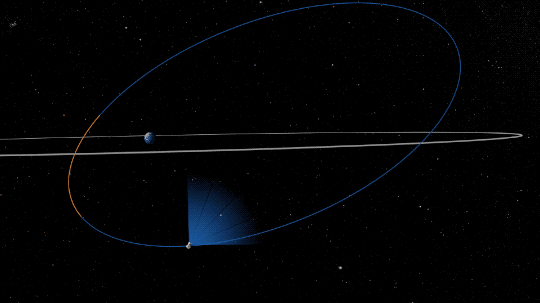
Kepler’s goal was to figure out how common Earth-size planets might be. TESS’s mission is to find exoplanets around bright, nearby stars so future missions, like our James Webb Space Telescope, and ground-based observatories can learn what they’re made of and potentially even study their atmospheres. TESS will provide a catalog of thousands of new subjects for us to learn about and explore.
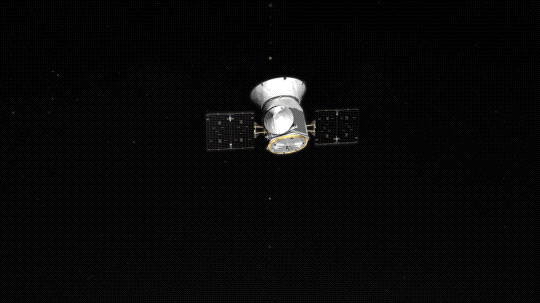
The TESS mission is led by MIT and came together with the help of many different partners. Learn more about TESS and how it will further our knowledge of exoplanets, or check out some more awesome images and videos of the spacecraft. And stay tuned for more exciting TESS news as the spacecraft launches!
Watch the Launch + More!

Sunday, April 15
11 a.m. EDT - NASA Social Mission Overview
Join mission experts to learn more about TESS, how it will search for worlds beyond our solar system and what scientists hope to find! Have questions? Use #askNASA to have them answered live during the broadcast.
Watch HERE.
1 p.m. EDT - Prelaunch News Conference
Get an update on the spacecraft, the rocket and the liftoff operations ahead of the April 16 launch! Have questions? Use #askNASA to have them answered live during the broadcast.
Watch HERE.
3 p.m. EDT - Science News Conference
Hear from mission scientists and experts about the science behind the TESS mission. Have questions? Use #askNASA to have them answered live during the broadcast.
Watch HERE.
4 p.m. EDT - TESS Facebook Live
This live show will dive into the science behind the TESS spacecraft, explain how we search for planets outside our solar system and will allow you to ask your questions to members of the TESS team.
Watch HERE.
Monday, April 16
10 a.m. EDT - NASA EDGE: TESS Facebook Live
This half-hour live show will discuss the TESS spacecraft, the science of searching for planets outside our solar system, and the launch from Cape Canaveral.
Watch HERE.
1 p.m. EDT - Reddit AMA
Join us live on Reddit for a Science AMA to discuss the hunt for exoplanets and the upcoming launch of TESS!
Join in HERE.
6 p.m. EDT - Launch Coverage!
TESS is slated to launch at 6:32 p.m. EDT on a SpaceX Falcon 9 rocket from our Kennedy Space Center in Florida.
Watch HERE.
Make sure to follow us on Tumblr for your regular dose of space: http://nasa.tumblr.com
3K notes
·
View notes
Text
New NASA X-Plane Construction Begins Now

NASA’s aeronautical innovators are ready to take things supersonic, but with a quiet twist.
For the first time in decades, NASA aeronautics is moving forward with the construction of a piloted X-plane, designed from scratch to fly faster than sound with the latest in quiet supersonic technologies.
The new X-plane’s mission: provide crucial data that could enable commercial supersonic passenger air travel over land.

To that end, NASA on April 2 awarded a $247.5 million contract to Lockheed Martin Aeronautics Company of Palmdale, Calif., to build the X-plane and deliver it to the agency’s Armstrong Flight Research Center in California by the end of 2021.
“It is super exciting to be back designing and flying X-planes at this scale,” said Jaiwon Shin, NASA’s associate administrator for aeronautics. “Our long tradition of solving the technical barriers of supersonic flight to benefit everyone continues.”
The key to success for this mission – known as the Low-Boom Flight Demonstrator – will be to demonstrate the ability to fly supersonic, yet generate sonic booms so quiet, people on the ground will hardly notice them, if they hear them at all.
Current regulations, which are based on aircraft speed, ban supersonic flight over land. With the low-boom flights, NASA intends to gather data on how effective the quiet supersonic technology is in terms of public acceptance by flying over a handful of U.S. cities, which have yet to be selected.
The complete set of community response data is targeted for delivery in 2025 to the Federal Aviation Administration (FAA) and the International Civil Aviation Organization (ICAO) from which they can develop and adopt new rules based on perceived sound levels to allow commercial supersonic flight over land.
Years of sonic boom research, beginning with the X-1 first breaking the sound barrier in 1947 – when NASA was the National Advisory Committee for Aeronautics – paved the way for the Low-Boom Flight Demonstration X-plane’s nearly silent treatment of supersonic flight.

The answer to how the X-plane's design makes a quiet sonic boom is in the way its uniquely-shaped hull generates supersonic shockwaves. Shockwaves from a conventional aircraft design coalesce as they expand away from the airplane’s nose and tail, resulting in two distinct and thunderous sonic booms.
But the design’s shape sends those shockwaves away from the aircraft in a way that prevents them from coming together in two loud booms. Instead, the much weaker shockwaves reach the ground still separated, which will be heard as a quick series of soft thumps – again, if anyone standing outside notices them at all.
It’s an idea first theorized during the 1960s and tested by NASA and others during the years since, including flying from 2003-2004 an F-5E Tiger fighter jetmodified with a uniquely-shaped nose, which proved the boom-reducing theory was sound.
NASA’s confidence in the Low-Boom Flight Demonstration design is buoyed by its more recent research using results from the latest in wind-tunnel testing, and advanced computer simulation tools, and actual flight testing.
Recent studies have investigated methods to improve the aerodynamic efficiency of supersonic aircraft wings, and sought to better understand sonic boom propagation through the atmosphere.
Even a 150-year-old photographic technique has helped unlock the modern mysteries of supersonic shockwave behavior during the past few years.
“We’ve reached this important milestone only because of the work NASA has led with its many partners from other government agencies, the aerospace industry and forward-thinking academic institutions everywhere,” said Peter Coen, NASA’s Commercial Supersonic Technology project manager.
So now it’s time to cut metal and begin construction.
The X-plane’s configuration will be based on a preliminary design developed by Lockheed Martin under a contract awarded in 2016. The proposed aircraft will be 94 feet long with a wingspan of 29.5 feet and have a fully-fueled takeoff weight of 32,300 pounds.
The design research speed of the X-plane at a cruising altitude of 55,000 feet is Mach 1.42, or 940 mph. Its top speed will be Mach 1.5, or 990 mph. The jet will be propelled by a single General Electric F414 engine, the powerplant used by F/A-18E/F fighters.
A single pilot will be in the cockpit, which will be based on the design of the rear cockpit seat of the T-38 training jet famously used for years by NASA’s astronauts to stay proficient in high-performance aircraft.
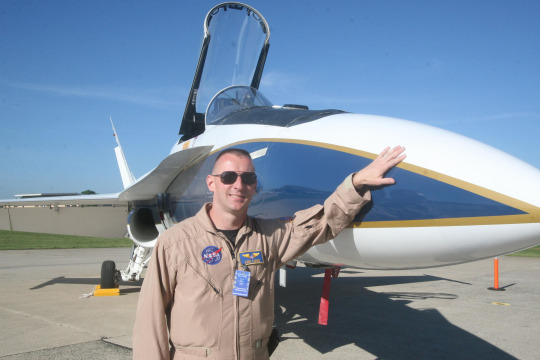
Jim Less is one of the two primary NASA pilots at Armstrong who will fly the X-plane after Lockheed Martin’s pilots have completed initial test flights to make sure the design is safe to fly.
“A supersonic manned X-plane!” Less said, already eager to get his hands on the controls. “This is probably going to be a once-in-a-lifetime opportunity for me. We’re all pretty excited.”
Less is the deputy chief pilot for Low-Boom Flight Demonstration. He and his boss, chief pilot Nils Larson, have already provided some input into things like cockpit design and the development of the simulators they will use for flight training while the aircraft is under construction.
“It’s pretty rare in a test pilot’s career that he can be involved in everything from the design phase to the flight phase, and really the whole life of the program,” Less said.
The program is divided into three phases and the tentative schedule looks like this:
2019 – NASA conducts a critical design review of the low-boom X-plane configuration, which, if successful, allows final construction and assembly to be completed.
2021 – Construction of the aircraft at Lockheed Martin’s Skunk Works facility in Palmdale is completed, to be followed by a series of test flights to demonstrate the aircraft is safe to fly and meets all of NASA’s performance requirements. The aircraft is then officially delivered to NASA, completing Phase One.
2022 – Phase Two will see NASA fly the X-plane in the supersonic test range over Edwards to prove the quiet supersonic technology works as designed, its performance is robust, and it is safe for operations in the National Airspace System.
2023 to 2025 – Phase Three begins with the first community response test flights, which will be staged from Armstrong. Further community response activity will take place in four to six cities around the U.S.
All of NASA’s aeronautics research centers play a part in the Low-Boom Flight Demonstration mission, which includes construction of the demonstrator and the community overflight campaign. For the low-boom flight demonstrator itself, these are their roles:
Ames Research Center, California — configuration assessment and systems engineering.
Armstrong Flight Research Center, California — airworthiness, systems engineering, safety and mission assurance, flight/ground operations, flight systems, project management, and community response testing.
Glenn Research Center, Cleveland — configuration assessment and propulsion performance.
Langley Research Center, Virginia — systems engineering, configuration assessment and research data, flight systems, project management, and community response testing.
“There are so many people at NASA who have put in their very best efforts to get us to this point,” said Shin. “Thanks to their work so far and the work to come, we will be able to use this X-plane to generate the scientifically collected community response data critical to changing the current rules to transforming aviation!”
youtube
Jim Banke
Aeronautics Research Mission Directorate
59 notes
·
View notes
Text
Why We Celebrate Search and Rescue Technologies on 4/06
Today (4/06), we celebrate the special radio frequency transmitted by emergency beacons to the international search and rescue network.
This 406 MHz frequency, used only for search and rescue, can be “heard” by satellites hundreds of miles above the ground! The satellites then “forward” the location of the beacon back to Earth, helping first responders locate people in distress worldwide, whether from a plane crash, a boating accident or other emergencies.

Our Search and Rescue office, based out of our Goddard Space Flight Center, researches and develops emergency beacon technology, passing the technology to companies who manufacture the beacons, making them available to the public at retail stores. The beacons are designed for personal, maritime and aviation use.

The search and rescue network, Cospas-Sarsat, is an international program that ensures the compatibility of distress alert services with the needs of users. Its current space segment relies on instruments onboard low-Earth and geosynchronous orbiting satellites, hundreds to thousands of miles above us.
Space instruments forward distress signals to the search and rescue ground segment, which is operated by partner organizations around the world! They manage specific regions of the ground network. For example, the National Oceanic and Atmospheric Administration (NOAA) operates the region containing the United States, which reaches across the Atlantic and Pacific Oceans as well as parts of Central and South America.

NOAA notifies organizations that coordinate search and rescue efforts of a 406 MHz distress beacon’s activation and location. Within the U.S., the U.S. Air Force responds to land-based emergencies and the U.S. Coast Guard responds to water-based emergencies. Local public service organizations like police and fire departments, as well as civilian volunteers, serve as first responders.

Here at NASA, we research, design and test search and rescue instruments and beacons to refine the existing network. Aeronautical beacon tests took place at our Langley Research Center in 2015. Using a 240-foot-high structure originally used to test Apollo spacecraft, our Search and Rescue team crashed three planes to test the survivability of these beacons, developing guidelines for manufacturers and installation into aircraft.

In the future, first responders will rely on a new constellation of search and rescue instruments on GPS systems on satellites in medium-Earth orbit, not hundreds, but THOUSANDS of miles overhead. These new instruments will enable the search and rescue network to locate a distress signal more quickly than the current system and achieve accuracy an order of magnitude better, from a half mile to approximately 300 feet. Our Search and Rescue office is developing second-generation 406 MHz beacons that make full use of this new system.
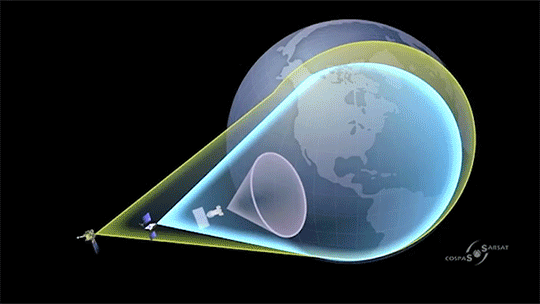
We will also incorporate these second-generation beacons into the Orion Crew Survival System. The Advanced Next-Generation Emergency Locator (ANGEL) beacons will be attached to astronaut life preservers. After splashdown, if the Orion crew exits the capsule due to an emergency, these beacons will make sure we know the exact location of floating astronauts! Our Johnson Space Center is testing this technology for used in future human spaceflight and exploration missions.

If you’re the owner of an emergency beacon, remember that beacon registration is free, easy and required by law.
To register your beacon, visit: beaconregistration.noaa.gov
Make sure to follow us on Tumblr for your regular dose of space: http://nasa.tumblr.com
1K notes
·
View notes
Photo

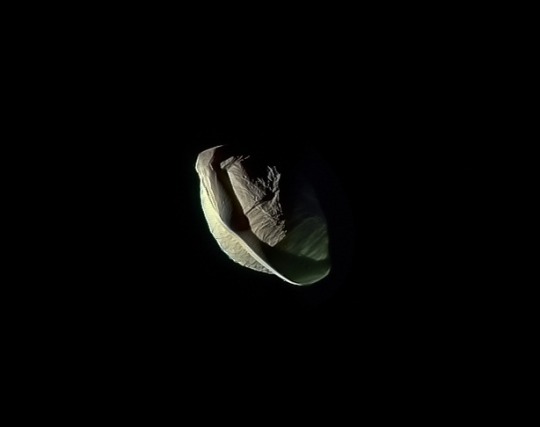

Pan (moon of Saturn) - March 07 2017
NASA/JPL-Caltech/SSI/Kevin M. Gill
3K notes
·
View notes
Video
youtube
NASA’s Transiting Exoplanet Survey Satellite (TESS)
The Transiting Exoplanet Survey Satellite (TESS) is the next step in the search for planets outside of our solar system, including those that could support life. The mission will find exoplanets that periodically block part of the light from their host stars, events called transits.
TESS will survey 200,000 of the brightest stars near the sun to search for transiting exoplanets. The mission is scheduled to launch in 2018.
The TESS launch date is NLT June 2018 (the current working launch date is April 2018).
Music: "Prototype" and "Trial" both from Killer Tracks. Credit: NASA’s Goddard Space Flight Center
NASA Goddard Space Flight Center
10 notes
·
View notes
Text
Two Virginia Schools Make Final Cut in Space Station Contest
Two Hampton Roads high schools will soon have their creations judged by NASA to see if they make it aboard the International Space Station. One is a food recipe for astronauts. The other is hardware for the space station.

Students from Phoebus High School prepare their breakfast dish at HUNCH's Preliminary Culinary Challenge at NASA's Langley Research Center.
Credits: NASA/David C. Bowman
Both projects are part of a NASA program called HUNCH, or High school students United with NASA to Create Hardware.
NASA’s Langley Research Center in Hampton, Virginia, hosted a preliminary culinary challenge March 5, where two schools cooked up a breakfast entrée. The shrimp and grits with gouda cheese dish from Phoebus High School in Hampton made it to the final competition at NASA’s Johnson Space Center in Houston scheduled for April 26.
Their work will be judged by Johnson Food Lab personnel, industry professionals, the space station program office, and astronauts for quality and taste. They’ll also be rated on a research paper and presentation video. The winning entree will be created by the Johnson Space Food Lab and sent up to the space station for astronauts to enjoy.
Space Hardware
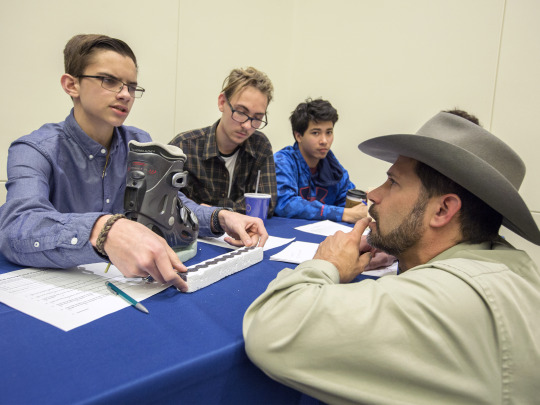
Poquoson High School student Travis Redman, left, talks with Glenn Johnson, a design engineer at NASA's Johnson Space Center, about an astronaut boot that would lock in place preventing floating in a no gravity environment.
Credits: NASA/George Homich
Langley also hosted a critical design review March 6, when four schools showed off the real-world products they fabricated to tackle challenges faced by astronauts living in space. The team from Poquoson High School in Poquoson, Virginia, was selected as a finalist and faces a final design and prototyping review April 25 at Johnson.
The hardware includes a pin kit, can squisher, exercise harness, crew reminder tool, location app tool, and hygiene caddy. Many of the hardware projects are items personally requested by space station crew.
The North Carolina School of Science and Mathematics, who also presented their projects at Langley, will join Poquoson High to present their works at Johnson. The projects the team from the Durham-based school had were an augmented reality object identification annotation tool, automatic location stowage system, and a single point exercise harness.
“The HUNCH Program can change the trajectory of a student’s life, by providing various avenues beyond the STEM (science, technology, engineering and math) field and opportunities to participate in the global effort to research in space,” said Yolanda Watford Simmons, manager of Langley’s HUNCH program.
In 2015, a culinary team from Phoebus High won the culinary challenge and their entrée, Jamaican rice and beans with coconut milk, is now included in an astronaut cookbook. Read more on their success here.
For more information on HUNCH, go here.
Eric Gillard
NASA Langley Research Center
2 notes
·
View notes